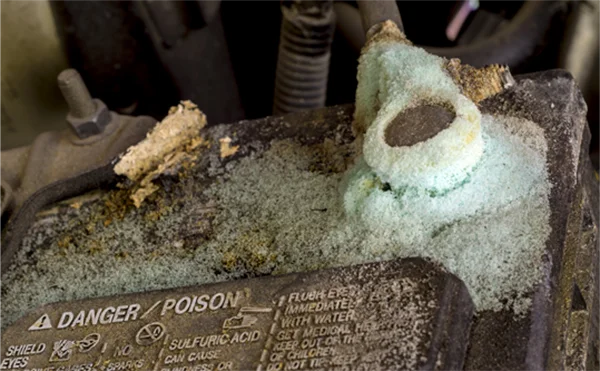Visit Green Cubes at MEDICA 2025, Dusseldorf, Germany November 17-20, 2025, Booth: Hall 12 / D58
Workplace Safety
Workplace injuries are all too common in the warehouses and battery maintenance for material handling equipment is a typical culprit. The ongoing maintenance required to keep flooded lead acid batteries running presents a danger to the workers tasked with charging, watering and changing batteries.
Batteries power equipment on construction sites, in tractors, trucks and automobiles; and most of them contain hazardous substances like lead and sulfuric acid. Unless workers who maintain, recharge and operate batteries know the risks and how to mitigate them, they can suffer severe workplace injuries. New Lithium-ion batteries eliminate most of these issues because they are self-contained and maintenance-free. Iron phosphate, a subset of Li-ion is the safest chemistry available, and its long cycle life means that it will last the lifetime of the truck.
Lead-Acid Batteries: Hazards, Precautions and Maintenance
The charging of lead-acid batteries is hazardous, but many workers may not remember this since the activity is so routine. The three most common risks are hydrogen gas formation when the battery is being charged, exposure to sulfuric acid from spills and leaks, and physical injuries from the batteries’ weight. Repetitive use injuries, such as sprains and strains are common. Also the highly corrosive electrolytes in batteries can cause respiratory irritation, eye damage, skin irritation, and can even erode tooth enamel. The sheer size of material handling batteries means that crush injuries also occur during battery changes.

The corrosive electrolyte material is shown in the image of a damaged lead acid-battery.
This is an overview of the risky maintenance for lead-acid batteries:
- The fluid level is extremely important and a safe level requires regular watering. Overwatering and underwatering can both damage the battery. If too much water was added before charging, the electrolyte levels will expand and cause the battery to overflow and damage the battery.
- Conventional batteries contain a liquid “electrolyte” which is a mixture of sulfuric acid and water. The plates in a lead battery contain an active material that should be continuously bathed in electrolytes while oxygen and hydrogen gas are released during charging.
- When batteries are being recharged, they generate hydrogen gas that is explosive in certain concentrations in air, so the ventilation system must provide enough fresh air to prevent an explosion.
- The electrical voltage created by batteries can ignite flammable materials and cause severe burns. Workers have been injured and killed when loose or sparking battery connections ignited gasoline and solvent fumes during vehicle maintenance.
- Wear personal protection equipment such as protective eyewear and gloves when working on batteries. Splashing acid is a risk, and personal protective equipment like chemical splash goggles, a face shield and gloves must be worn when working on batteries.
- First aid facilities, eye wash stations, and emergency showers are necessary to reduce the severity of accidental contacts.
Safety Features of Li-ion Batteries
Li-ion batteries are becoming more and more common because of their long cycle life and short charge times, but they also greatly reduce the risk to the workforce when they are implemented in a warehouse environment. Li-ion batteries are made up of cells, just like lead-acid batteries. Large format Li-ion cells, used to manufacture batteries used for motive applications, are shown in the picture. The cells have an anode and a cathode with a separator and electrolyte in between. Unlike flooded lead acid cells, the li-ion cells are sealed and have many safety factors designed in them. The cathode material is the main determining factor in the cell’s performance. In the battery power market today, there is a myriad of available battery cathode chemistries to choose from.
It is a critical decision which not only impacts how well the product will operate but also how safely it can operate. Factors such as how much power is required, the time required to charge, operating temperatures, operating environment, packaging dimensions, and weight are all examples of key parameters that must be considered.
Next Event
Latest News
Customer Ratings and Reviews
Green Cubes is a great company, great engineers, great product. That’s been kind of my number one go to [lithium] battery.
President Industrial Power Company
The thing I like about Green Cubes is that they have other lines of business outside of material handling batteries, they have been in the lithium world for a long time. I can trust they will likely stay in business
VP Industrial Battery Company
Green Cubes [differentiates] on its capability to custom design for things like the hardware, the firmware, and inverters. They also have economies of scale because they make battery systems for things like forklifts.
VP Powered Cart OEM
I am doing some work with them right now. We’re learning their products, and looking at demos. They have good people. They seem like they know the technology well – they say they’re a technology company. I like that they’ve been in the lithium business a long time. I can trust they will likely stay in business.
Sales Manager Industrial Battery Company
Green Cubes Technology would be my go-to for lithium applications.
Branch Manager OEM
I’ve told my friends at Green Cubes, I don’t plan on going anywhere. I believe in loyalty.
